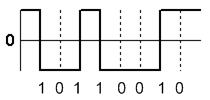Back
Next
Technique : NRZI - non-return to zero invert.
Use change in signal to represent one of the bit values.
 In example above,
Transition (in either direction) represents a 1.
Bit density high.
The transitioning bit can be used to re-sync timing.
Even if wiring switched, transition still correctly identifiable.
Historically, a transition represents a 1,
but different protocols may represent 0s by transition.
Problems :
Long strings of zeros still problematic.
Possible Solution:
Limit the run of non-transition bits to keep within error range.
Bit stuffing.
Stuff a transition bit after a specific length of non-transition bits.
USB 1,2 uses bit stuffing.
USB uses transition to represent 0
Stuffs a 0 after 6 sequential 1s.
Even if then next bit is a 0, it stuff an additional 0.
If 7 1s detected, signals error to sender.
It must see a zero, which it will always discard.
Use RLL - run length limited encoding.
The majority of technologies use RLL
Hard drives.
USB 3
Next
In example above,
Transition (in either direction) represents a 1.
Bit density high.
The transitioning bit can be used to re-sync timing.
Even if wiring switched, transition still correctly identifiable.
Historically, a transition represents a 1,
but different protocols may represent 0s by transition.
Problems :
Long strings of zeros still problematic.
Possible Solution:
Limit the run of non-transition bits to keep within error range.
Bit stuffing.
Stuff a transition bit after a specific length of non-transition bits.
USB 1,2 uses bit stuffing.
USB uses transition to represent 0
Stuffs a 0 after 6 sequential 1s.
Even if then next bit is a 0, it stuff an additional 0.
If 7 1s detected, signals error to sender.
It must see a zero, which it will always discard.
Use RLL - run length limited encoding.
The majority of technologies use RLL
Hard drives.
USB 3
Next
 In example above,
Transition (in either direction) represents a 1.
Bit density high.
The transitioning bit can be used to re-sync timing.
Even if wiring switched, transition still correctly identifiable.
Historically, a transition represents a 1,
but different protocols may represent 0s by transition.
Problems :
Long strings of zeros still problematic.
Possible Solution:
Limit the run of non-transition bits to keep within error range.
Bit stuffing.
Stuff a transition bit after a specific length of non-transition bits.
USB 1,2 uses bit stuffing.
USB uses transition to represent 0
Stuffs a 0 after 6 sequential 1s.
Even if then next bit is a 0, it stuff an additional 0.
If 7 1s detected, signals error to sender.
It must see a zero, which it will always discard.
Use RLL - run length limited encoding.
The majority of technologies use RLL
Hard drives.
USB 3
Next
In example above,
Transition (in either direction) represents a 1.
Bit density high.
The transitioning bit can be used to re-sync timing.
Even if wiring switched, transition still correctly identifiable.
Historically, a transition represents a 1,
but different protocols may represent 0s by transition.
Problems :
Long strings of zeros still problematic.
Possible Solution:
Limit the run of non-transition bits to keep within error range.
Bit stuffing.
Stuff a transition bit after a specific length of non-transition bits.
USB 1,2 uses bit stuffing.
USB uses transition to represent 0
Stuffs a 0 after 6 sequential 1s.
Even if then next bit is a 0, it stuff an additional 0.
If 7 1s detected, signals error to sender.
It must see a zero, which it will always discard.
Use RLL - run length limited encoding.
The majority of technologies use RLL
Hard drives.
USB 3
Next